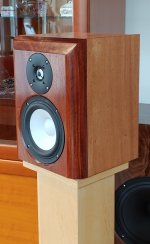It doesn't work that way. You are stating as a fact what is only your idea of how diffraction works.
If my description of my experience came across as a statement of fact, I am sorry I was not more clear.
In my experience with a small baffle with large roundovers, "Edge" predicted the baffle step gain best when using the smaller uncut area of the baffle, rather than the larger outer cabinet dimensions. It is a subtle difference, in the range of 1.5 db at 1kHz. But the smaller baffle area simulation more closely matched the measured result.
To be clear, I am talking only about the baffle step gain, not the higher frequency ripples.
Attachments
Yes, I agree.Bottom line: a small change in baffle dimensions while including a 3/4" edge radius will be fine. Maybe even better.
Even if for example we were talking about an already built unit and the pros and cons of extending a roundover. The smoothness up top is the better benefit out of the three mentioned effects.
How anyway does the lower step get dealt with.. in the crossover if proven necessary. Smoother edges are a better way to deal with diffraction and if this means a crossover tweak, the result could theoretically be better all up.
I have become a firm proponent of beveled or radiused baffle edges, for all the reasons you mention AllenB.
In my case, my tweeter response was indistinguishable from the measured infinite baffle case. There was simply no measurably significant diffraction ripple at all in the 3k - 20k region. And the horizontal off-axis response at +/- 30 degrees was the same as the on axis response, except for the roll-off above 9kHz.
Now I am attempting (after the fact) to simulate the what I measured.
In my case, my tweeter response was indistinguishable from the measured infinite baffle case. There was simply no measurably significant diffraction ripple at all in the 3k - 20k region. And the horizontal off-axis response at +/- 30 degrees was the same as the on axis response, except for the roll-off above 9kHz.
Now I am attempting (after the fact) to simulate the what I measured.
